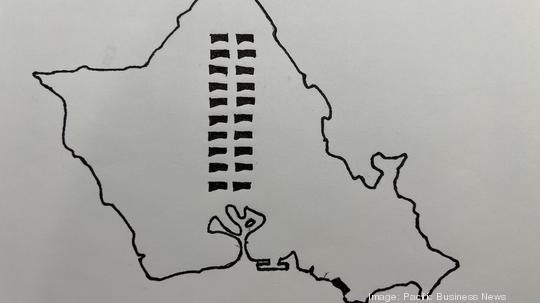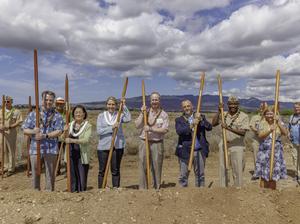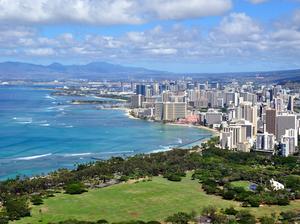
Last week, I shared some rough calculations about how many acres of solar-plus-storage facilities Oahu will need if we intend to replace fossil fuels with solar energy.
Based on the latest facility we’ve covered, the Kupono Solar Project, I came up with a minimum of 4,847 acres — the equivalent of 2.2 Waikikis — just to provide power, and four hours of battery back-up, for Oahu’s existing housing.
Readers have responded with math that fills in the gaps of my estimate. Gaps such as Oahu’s future electricity appetite if we replace all our cars with electric vehicles, and what our daily electricity appetite is when all users are included, not just residential customers.
The number of Waikiki-equivalents keep adding up.
Stan Osserman, of Tigershark Energy Consulting Hawaii, noted, “You omitted the fact that we are also expected to go to all EVs, so you can multiply your final number by 2.3 to account for that.”
That takes us to the equivalent of five Waikikis worth of solar facilities for housing, plus EVs.
I also heard from Clint Churchill, president of the Practical Policy Institute of Hawaii, which I referenced last week for its realistic take on sea-level rise. My estimate was for residential only, as I noted. That left out a lot more electricity than I realized. According to Churchill, citing U.S. Energy Information Administration stats for Hawaii, “residential comprises 30% of the aggregate of residential, commercial, and industrial Btu consumption (37 trillion Btu out of 123 trillion total). So it would be logical to multiply your 4,847 calculation by 3.33, which would yield 16,140 acres.”
But wait, there’s more! The facilities being built on Oahu vary in how much energy they produce, and store, per acre of land.
“The Kupono Solar Project, at 3.11 acres per MW of capacity, is perhaps the most land use-efficient solar project in the state,” he wrote. “Projects range up to nine acres per MW, with several at seven. That’s worth noting since other future projects might not be as efficient — at four acres per MW, for example, the 16,140 acres derived above increases to 20,759 acres.”
Churchill also looked at the electrical burden of switching to EVs, and said, “A relatively small percentage of EVs will receive their energy from the owner’s rooftop. The best study I’ve come across is from transportation consultant Michael L. Sena in The Dispatcher. He estimates a 49% increase in installed electricity generation capacity to handle a complete transition to EVs in the U.S.”
Bottom line? Churchill said, “It’s our belief that it will take at least 20,000 acres of solar panels to power Oahu, assuming wind power is all but dead.”
That’s at least 10 Waikiki’s worth of facilities, most of which haven’t been built yet. I mentioned, without quantifying, that we have spent decades building solar. Churchill found Hawaiian Electric figures that, “We’re at over 37% of rooftops on Oahu, tops in the nation. ... [F]or 2021, 13.3% of power generation is from ‘customer-sited grid-connected renewables,’ which includes solar on warehouses and other commercial/industrial [properties].”
Which means nearly 87% of the solar we will need hasn’t even arrived yet.
Finally, a professional in the STEM world, who asked to remain anonymous, sent the highest estimate I’ve seen yet. It’s best if I quote this person’s work directly, given its complexity:
- “Oahu’s current electrical power use averaged over the course of the day is about 1 GW.
- “Replacing gasoline-powered vehicles with those powered by batteries or locally produced hydrogen would require roughly doubling Oahu’s electricity generation capacity, to [a] 2 GW daily average.
- “To provide adequate power during the evening usage peak and at night, a third to a half of all generated solar power would need to be temporarily stored in grid-scale battery systems, at an efficiency of about 85%. This raises the required daily average generating capacity to about 2.1-2.2 GW.
- “For solar panels at Honolulu’s latitude, the daily average generating capacity is roughly equivalent to four hours at their peak noon-time capacity. Thus, Oahu’s solar panels would need to have a grand total peak generating capacity of ( 24/2 ) *2.2 GW = 13.2 GW.
- “Typical noon-time solar irradiance at Earth’s surface is 1.0 kW/m^2 (provided that the sky is cloud-free).
- “Typical real-life energy conversion efficiency for grid-scale solar panels is 15%. Thus, a solar panel’s peak generating capacity is typically around 150 W/m^2.
- “Even on a well-designed solar farm, only about 50% of the total area is covered by solar panels. This brings us down to 75 W/m^2.”
With those inputs, this reader’s formula is “13.2 GW / 75 W/m^2 = 176 km^2 = 68 sq. mi.”
Put simply, “[F]or solar power to provide 100% of Oahu’s electric power needs by year 2045, approximately 11% of Oahu’s total land area (‘20 Waikikis’) would need to be covered with solar farms. Technology improvements may cut this down a little, but not by much.”
The only thing I could add to that is a sketch, to scale, of what 20 Waikikis of land looks like. And it looks like ... wow!







